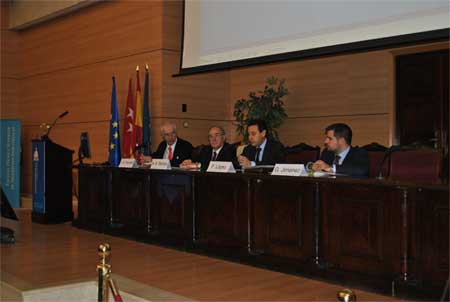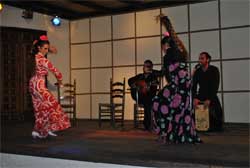

NESTet 2013 – Putting the spotlight on nuclear education and training
NESTet 2013 is a well-known international conference organised every two years by the European Nuclear Society (ENS). Its main aim is to promote discussion of the the challenges that the industry is facing worldwide with regards to nuclear education and training and to analyse what progress has been achieved to date. This year’s event took place in Madrid and was organized by ENS in cooperation with the Spanish Nuclear Society (SNE). From 17-21 November 2013 NESTet brought together almost 124 specialists and trainees in the nuclear sector from all around the world, who delivered more than 80 presentations.
During the three days of the conference many interesting and revolutionary projects were presented in plenary and during the parallel sessions, which focused on the topics such as: What are the needs with regard to nuclear education and training? What are the answers which help closing that gap? What is the situation with respect to infrastructure and tools for nuclear education and training? How to ensure that enough motivated workforce is available for the nuclear sector? What are the interactions between nuclear education and civil society? The use of technologies for education and training, What are the experiences of countries with an emerging nuclear sector?

The opening session kicked off on Monday morning with a welcoming speech from Jean-Pol Poncelet, Director General of FORATOM. This was followed by speeches from A. Santos of the Spanish Nuclear Society and G. Jimenez from the Spanish Young Generation Network regarding the importance of developing complete and diverse education and training programmes, as well as the Spanish experience when it comes to nuclear education and training.
The first day of the conference continued with the plenary session chaired by J. Tipa from the UK’s National Skills Academy for Nuclear, which addressed the topics of maintaining nuclear competence within the EU, education, training and nuclear knowledge management. During the presentations it was emphasised that the nuclear industry should actively encourage the setting up of knowledge transfer mechanisms to ensure that the knowledge, know-how and experiences of the current generation of professionals within the industry is not lost to the young people entering a career in nuclear. The continuity of success depends on how we deal with that accumulated knowledge.
The second part of the day was dedicated to the parallel sessions, during which speakers and the participants worked together to find out the answers to the following issues: What are the needs with regard to nuclear education and training? What are the answers that help close the gap?
During her presentation A. Nakai (Japan) underlined the fact that cultivating human resources in the field of safety management is of prime concern in nuclear engneering and she gave as an example the case of Japan. In the immediate aftermath of the Fukushima accident poorly managed communications and cooperation, and a lack of experienced engineers in the field led to nothing but fear and concern for the safety of the population. This was further exacerbated by media and nuclear energy opponents. The most important lesson to be learned was that unless nuclear industry uses a highly-qualified workforce the outcome is extremely difficult to control and the damage can be permanent.
So, in order to cultivate a steady and sustainable safety culture in the field of nuclear engineering, Okayama University took the initiative to extend its programme and to identify opportunities for improving operation and safety for both the plant and personnel.
At the end of the first day participants enjoyed a traditional Spanish dinner which was hosted in an unique restaurant called Palacio del Negralejo, outside Madrid. A group of flamenco singers and dancers provided entertainment throughout the evening.
|
 |
It was a new way to get in touch with the participants, to socialise and to exchange opinions on various issues.
The second day of the conference began with two parallel sessions and continued with the Young Generation Workshop on the use of new technologies for education and training, chaired by Eileen Radde, Vice President of ENS – Young Generation Network.
One of the speakers, Mathias Lantz, a professor at Uppsala University in Sweden, caught the attention of the participants during the Young Generation Workshop by presenting a new educational tool called “Clickers”. It helps professors at the university to check on the students and to better interact with them during the classes. In my oppinion, it was one of the most appreciated presentations that was delivered during the conference, both for its quality and its usefulness to university professors’ everyday work.
On the last day one of the organisers, Emilia Janisz, announced the winner of the poster contest. During the previous two days participants were asked to review the 18 posters exhibited in the university hall and to vote for the best one. The winners were E. Corniani, U. Von Estorff and H. P. Ogden from the European Commision’s Joint Research Centre, Netherlands, who created the poster entitled “Augmented nuclear education”. The project they presented in the poster was about explaining how a nuclear power plant works and answering some of the most frequently asked questions. This innovative approach consists of enhancing the end-user experience and attracting his or her interest through the implementation of an ‘augmented reality
|
|
environment’ that blends digital objects with reality so that they appear in the user’s real-world environment.
Among the issues discused during the two parallel sessions on the third day was the fact that in order to succeed in education, to maintain and extend a competent workforce in nuclear industry, medical, research and even in governmental organisations, and to transfer the knowledge and know-how to the next generations, a collective effort and common vision are required from companies, governements, universities, institutes for research, etc. All the efforts aimed at developing programmes and activities focused on courses and training for both students and professionals, policy support regarding education and training in the nuclear field and guidance for young researchers.
At the end of the conference Eileen Radde presented some of the highlights of NESTet 2013 in the concluding remarks that she made together with J. Tipa. Their conclusions focused on the current challenges the industry is facing worldwide, on the importance of nuclear education and on the ability of the industry to maintain a qualified and capable workforce, especially after Fukushima.
The last day of NESTet 2013 was reserved for technical visits for the participants. They were asked to choose between three main objectives: TECNATOM, JUZBADO (The Nuclear Fuel Fabrication Plant) and ZORITA NPP (which is under decommisioning right now). I went to visit TECNATOM, together with other colleagues. The representatives of Tecnatom gave a presentation about the services they provide to enhance the quality and the standards of training provision. The Fukushima accident, which has left a permanent mark on the nuclear industry, prompted significant changes in the simulation training tools, which led to a thorough analysis of plants’ behaviour under severe accident conditions. In my opinion, it was a very interesting visit and we had the opportunity to see simulation tools used in the training programmes for different types of reactors and nuclear power plants.
I would like to emphasise that the members of the Spanish Nuclear Society and the Spanish Young Generation Network played an important role in the conference. Some of them were members of the organising team, while others delivered interesting speeches on the projects and activities they have developed to cover not only education but also training requiremnts for professionals.
One thing is clear after analysis, the nuclear industry is a challenging and motivational, constantly self-improving, future-oriented, dynamic and friendly environment in which to work.
Having had an opportunity to be the Young Generation reporter at NESTet 2013 was a wonderful and useful experience. It helped me to exchange of information, knowledge and experience with other nuclear specialists who come from a variety of backgrounds and from different countries across the world. As a Romanian Young Generation Reporter I am grateful to ENS for assigning me the task of being the reporter of the conference and for making the event a real success.
Livia Ioana Chitu
Young Generation Reporter
YGN Romania
|

